A Comprehensive Report on Hourly Wage Growth in the United States Hospitality Industry
As a leading hospitality employment platform, we often hear concerns about what is expected and competitive for hourly wages—and no wonder.
With consistently rising living costs and a notoriously challenging labor market (not to mention there are various minimum wages across the nation), the last few years have made figuring out a fair and attractive wage for hospitality work much more difficult.
To understand more, we pulled from our data of listed pay rates to find answers on how hourly wages have changed and uncover predictions on what the next three years will look like.
A Little Background Into Our Methods
Poached is a national hospitality employment platform with over 1,000,000 hospitality professionals looking for work on our site and over 70,000 food and beverage businesses advertising open roles under specific categories, including:
- Floor
- Kitchen
- Bar
- Management
- Barista
- Counter
- Hotel
- Distributor
Our audience comprises all hospitality business types, with a strong representation of small to medium-sized independent restaurants and groups in urban areas.
Since 2017, we’ve collected anonymous wage information on jobs posted on our platform, allowing us valuable insights into wage growth in the national hospitality industry.
This report summarizes our findings after analyzing 358,000 jobs posted with pay rates between 2017 and 2023.
How Have Wages In Hospitality Changed?
Our data shows wages and pay ranges (the minimum and maximum advertised for a role) have grown substantially across the U.S. between 2017 and 2023—rising at least 46% across all categories.
We saw a higher proportional increase in jobs listed under the Floor, Management, and Bar categories.
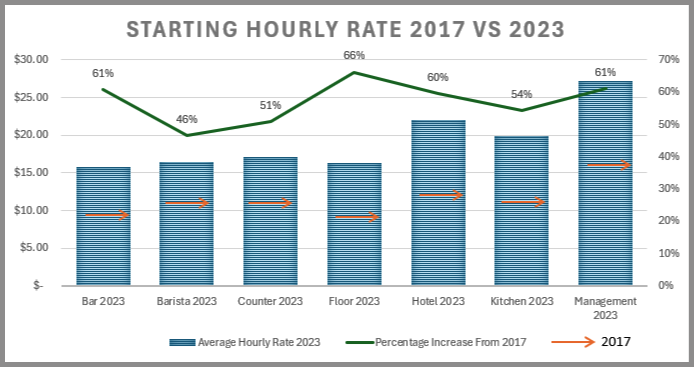
Before 2020, hospitality wages rose incrementally across all categories, with an average fluctuation of only $2.50 in the pay range.
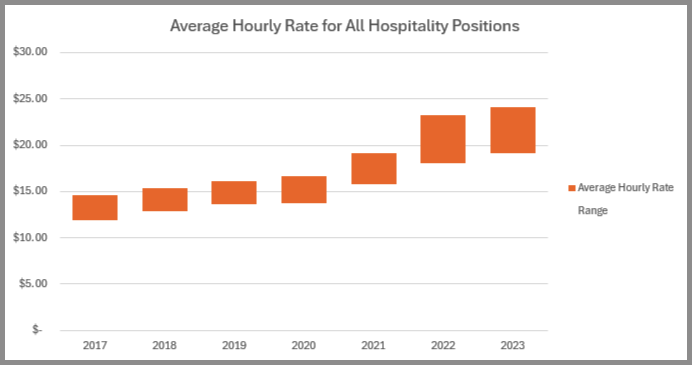
We saw a sharp increase in 2022 when the minimum hourly pay rate nearly matched the maximum hourly rate the previous year.
Additionally, the pay range broadens to $5.00 an hour, contributing to a more competitive labor market and likely increasing confusion on expected wages.
A Deeper Look at Wage Growth
The jobs listed under the Floor category on Poached include a wide range of front-of-house positions but more heavily represent server positions. Over the last six years, jobs in the Floor category saw a maximum wage increase of $10.00 with a variable pay range moving from $3.00 to around $6.00.
Jobs under the Floor category also had the highest proportional increase in hourly wage growth between 2017 and 2023 than any other category, coming in at 66%.
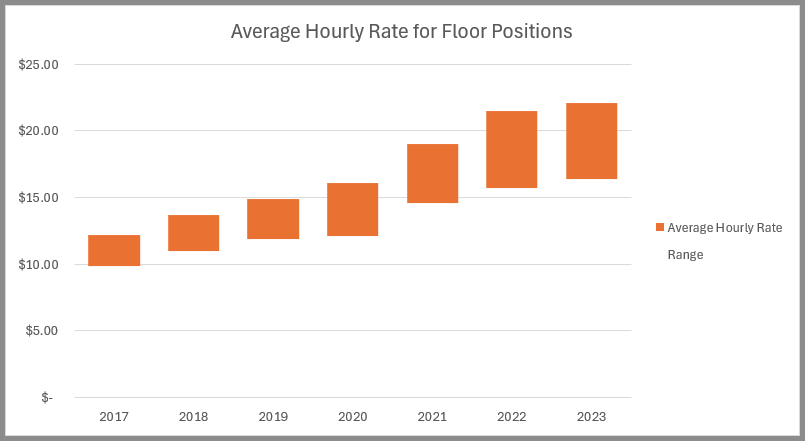
Skilled back-of-house positions, like Sous Chefs and Executive Chefs, also saw significant growth with an hourly pay raise ranging between $10-14.
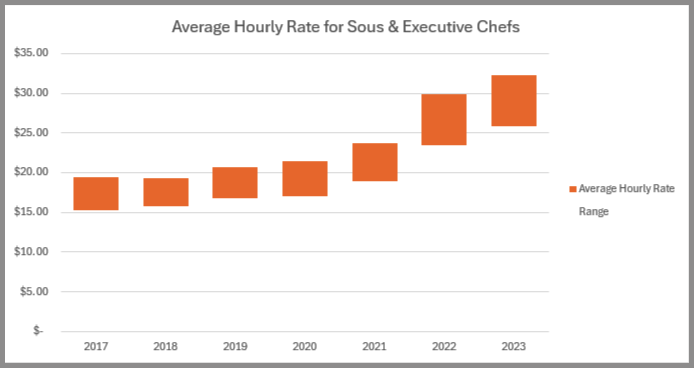
2022 brought a considerable increase, with the minimum pay rate for these back-of-house positions being only $0.30, lower than the average maximum rate from the prior year. The pay range also increased from $3.95 to almost $6.50.
To our surprise, entry-level positions like bussers, food runners, and dishwashers saw similar growth in pay rates around the same time. Still, the pay range shrunk to a margin of $0.05 in 2023, resulting in slight wage variation.
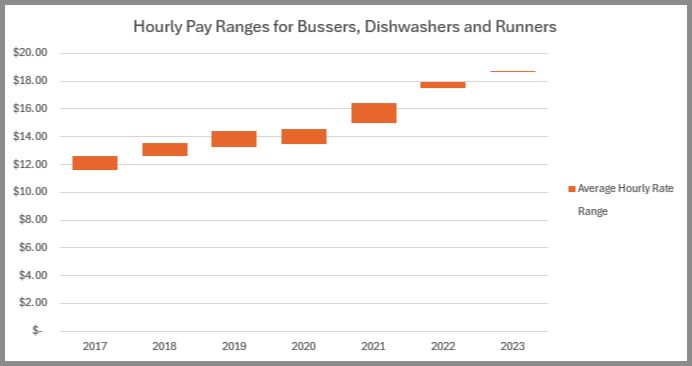
Other Influences on Hospitality Wage Increases
One major influence on hospitality wages is state and city ordinances raising the minimum wage to a livable level.
30 states and Washington D.C. have raised their minimum wage to above $8.00, a $0.75 raise from the federal minimum, frozen at $7.25 since 2009.
Additionally, 58 localities have minimum wages above their state’s. The most notable increases include the Seattle area, with a minimum wage of $19.71 in the SeaTac area and upwards of $20.29 in Tukwila, just south of Seattle. Other cities, like Denver, West Hollywood, and San Francisco, all have minimum wages above $18.00.

Regardless, even in states and cities where the federal minimum wage applies, all our core markets have averaged pay rates above $10.00 for hospitality positions since 2017.
When looking at trends in the Consumer Price Index (CPI) reported by the Bureau of Labor Statistics, the CPI increases between 2017 and 2023 coincided with wage growth during the same period.
Between January 2017 and January 2021, the average CPI for urban consumers grew steadily between 1.4% at the lowest and 2.5% at the highest. Come 2022, the CPI shot up to 7.5%—the same year we saw the most significant spike in wage growth.
Lastly, with the most significant wage increase taking place post-2020, COVID-19 played a part in the rise of wages in the hospitality industry.
In 2021, we surveyed our worker audience to gain insight into the workforce post-covid closures. Many of the 1700 respondents claimed that fears of COVID-19 and uncertainty about the food service industry kept them from returning to work.
As we all surely remember, this contributed to a very competitive labor market—making it significantly harder for hiring managers to attract talent and causing many to increase what they were willing to pay for a role.
The Future of Hospitality Wages
Averaging out annual increases across all hospitality categories, we can project that wages will continue to rise, reaching a range of $23.00 per hour up to $26.00 by 2026. Additionally, the pay range starts to shrink, limiting wage variation to $4.00 for the same position.
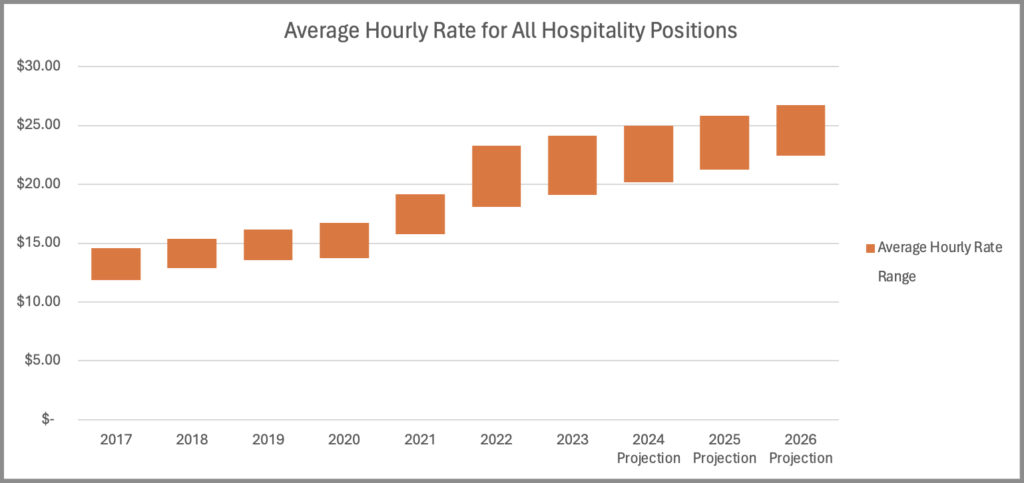
As wage increases stabilize and pay ranges shrink, we expect more consistency in labor costs and competition while maintaining overall pay growth.
Cooling off from the highly competitive hiring market we’ve experienced in the last few years will help hospitality businesses better navigate expected labor costs while attracting and retaining talent.
